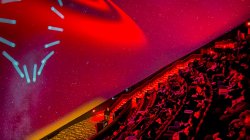Listening for Cosmic Clues
As a Liberty Science Center guest astronomer, Montclair State University Professor Marc Favata explored the ways we can ‘listen’ to space and time
Posted in: Homepage News, Research, Science and Technology

Under the cavernous dome of the Jennifer Chalsty Planetarium in the Liberty Science Center – the largest planetarium in the Western Hemisphere – Montclair State University Physics Professor Marc Favata led an audience on a listening tour of the cosmos.
In his Space Talk “Cosmic Clues from Gravitational Waves” on March 2, Favata explained how he and other scientists “listen” to the ripples of gravity to learn more about colliding black holes and neutron stars.
The Liberty Science Center’s Space Talk lecture series is billed as a “cosmic conversation” that shines a light on new areas of astronomy. The giant dome of the planetarium is described by the Liberty Science Center as being “the ideal venue for today’s working astronomers to share their pursuit of answers to the Big Unanswered Questions of the universe, from the secrets of black holes, to life on other planets, to the mysteries of dark matter, and beyond.”
In the last year alone, Space Talks have been given by astronomers from Princeton, MIT, Columbia, Rutgers and CUNY as well as a member of the James Webb telescope team.

While the Hubble and James Webb telescopes produce amazing images of our cosmos, Favata’s “Cosmic Clues from Gravitational Waves” talk explored the way scientists listen to the ripples of gravity to observe the mysteries of space and time. Using both images and sound, he explained that the gravitational waves – which evoke the image of a pebble being dropped into a pool of water, sending out gentle ripples through the universe – provide a kind of drumbeat that reveals more about colliding black holes and neutron stars than conventional telescopes.
“Gravitational waves are cool,” Favata says, “and we can use them to explore the universe in a different way than we have before, in a way that’s more like listening than watching. I’ll be talking about why they’re exciting, and what we can do with these new observations.”
Favata contributes to this research as a member of the LIGO Scientific Collaboration. In 2015 the Laser Interferometer Gravitational-wave Observatory (LIGO) made the first-ever detection of gravitational waves produced by the merger of two black holes.
“I want to help focus the public’s attention on that discovery,” he says. “It’s a huge project with lots of people, including myself and two other Montclair faculty members who each contribute a small piece to the bigger puzzle.”

The research conducted by Favata, who is also chair of the Physics and Astronomy department, focuses on modeling gravitational-waves from colliding neutron stars and black holes, and using those waves to explore the properties of stellar collisions and test Einstein’s theory of relativity.
Favata worked with the Planetarium team to bring his research to life with images from the Webb and Hubble telescopes on the giant dome, which is 89 feet in diameter and fully digital.
“Dr. Favata even used sound during the talk as a means of exploring the nature of gravitational waves and the massive, distant events (collisions of distant black holes and of neutron stars) that cause them,” Planetarium Director Mike Shanahan said after the Space Talk. “The visuals on the dome helped to bring to life the collisions of these distant objects vividly, and the sounds provided a down-to-earth means of helping the audience grasp these deep-space ideas.”


“It was great fun giving a talk in the Liberty Science Center’s planetarium,” Favata said afterward. “It’s a very impressive space. The staff there were very helpful in customizing my presentation to make full use of the dome. It was a great evening, and we had lots of questions afterwards in the Weston Family Lab for Earth and Space Exploration [funded by Montclair benefactor Josh Weston].”
The Space Talk series is held on the first Thursday of each month and coincides with the LSC After Dark events for patrons 21 and older, that include food, alcohol, dancing and exploration of the exhibits at night.
Story by Editorial Director Laura Griffin. Photos by University Photographer John J. LaRosa.
You might also like:
- Montclair Scientists Observe Collisions of Neutron Stars with Black Holes
- Professor Receives Prestigious NSF CAREER Award
- Professor Assists in Proving Einstein’s Theory Again
- Listening to the Universe
This article was featured in the Winter 2024 edition of Montclair magazine.
